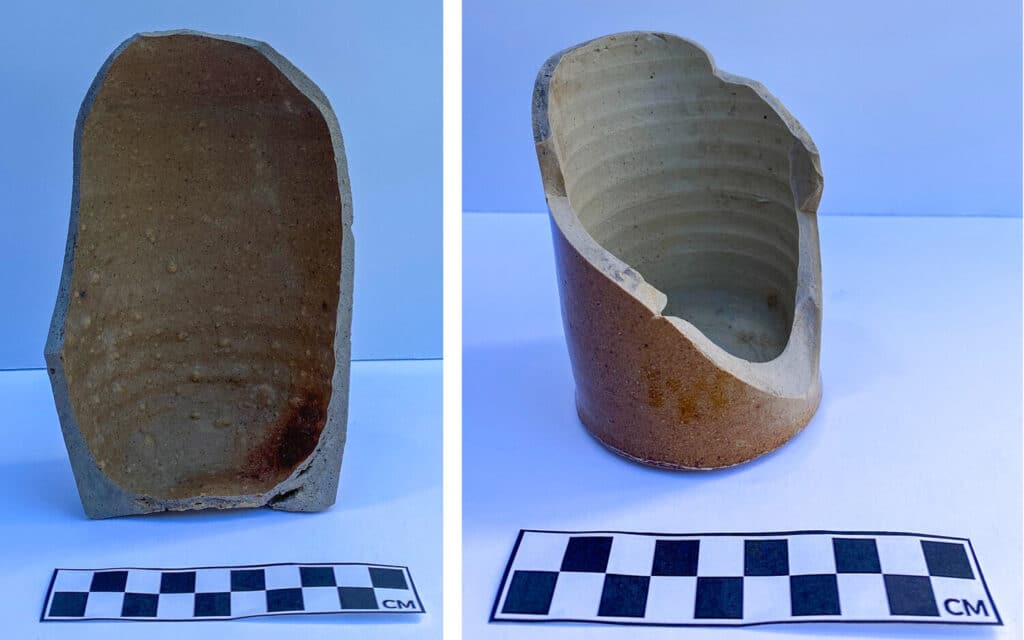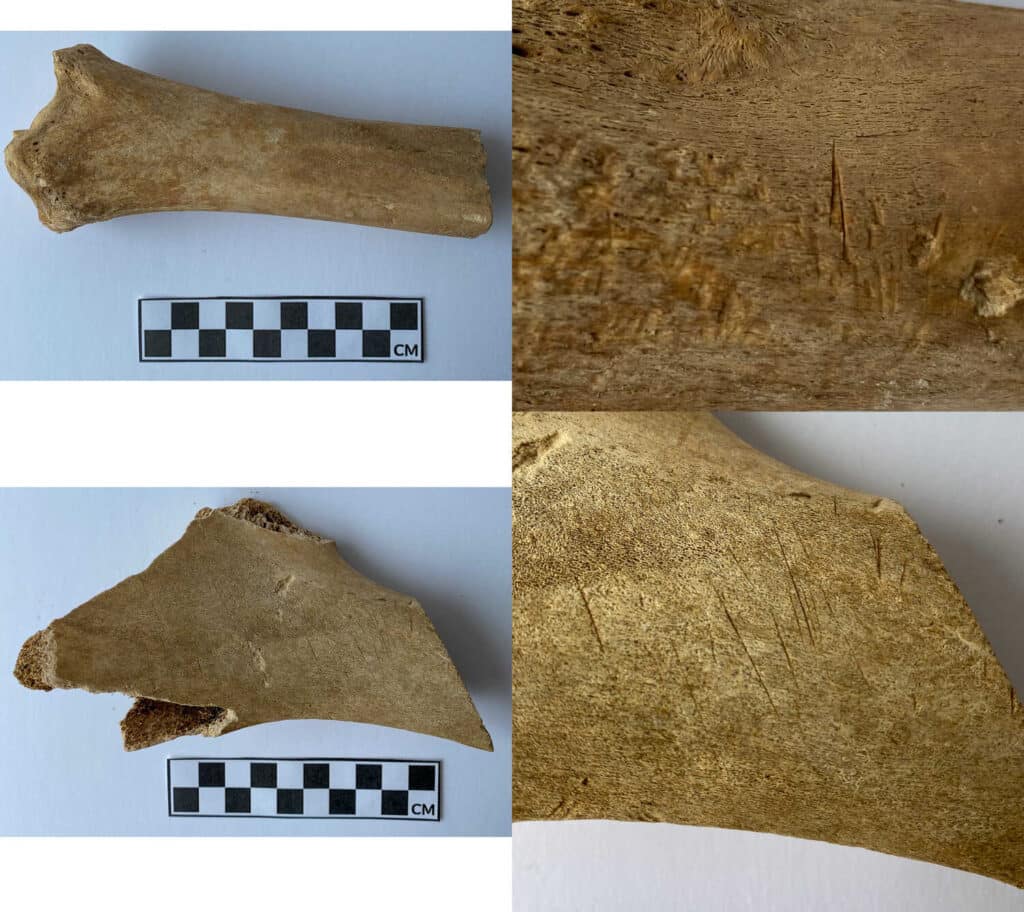During June 2022, while digging a trench for a new drainage pipe, construction workers uncovered dozens of objects that had been buried under the lawn of the Greenwich Historical Society. The objects were gathered and cleaned by members of staff and two Greenwich High School interns before being cataloged and researched.
Unfortunately, any dating of the objects has to be given in a broad range due to the fact that the order in which the objects were removed from the ground was not recorded and the surprising lack of any maker’s marks or labeling on any of the pottery fragments, means that there are no obvious provenances for the objects found. Despite this, there are still many things that can be learned from the objects about how people on our campus’ site were living in the 18th and 19th century. Below are some of the highlights of the discoveries.

Redware Jug:
The most complete piece of pottery that was found, this jug is in very good condition considering the centuries it has spent underground after being thrown away. The jug has a 51 cm diameter and is 20 cm tall and is very likely an example of locally made redware, a style of ceramic named after the color of clay after firing. The jug was thrown on a potter’s wheel, but is very asymmetrical and has traces of the potter’s fingers where they shaped the clay. The thickness of the ceramic itself is also quite varied throughout the body of the piece and the glaze is not applied evenly either. The jug does not have any maker’s mark or any other identifying information on it at all. All of these details suggest that this piece was made cheaply and quickly, likely for an average household’s daily use, likely for holding beer or water.
American Redware:

During the digging, several pieces of American redware were found, including the piece pictured here (fig. 2) the largest and only decorated piece amongst them. Redware was an incredibly
popular style of ceramic that was made and used extensively from the mid-18th century through to the late 19th century all over the northern United States. The fragment that is featured here is likely from the first half of the 19th century and likely comes from a serving dish or pie plate. The exterior is unglazed while the interior has a reddish-brown glaze with wavy yellow lines traveling around the diameter of the piece. This piece of redware was likely made nearby either in Connecticut or New York and would have been a common sight in kitchens of the rich and poor alike, in Figure 3 several replicas of this pottery style can be seen in the Bush-Holley House’s colonial kitchen.


Jaspé Pottery:
This fragment of yellow-glazed pottery with a brown polka dot bears a close resemblance with a style of ceramics from 19th century France called Jaspé ware. Jaspé pottery originates in the Savoie region of south-eastern France and typically dates to the late 19th century to the early 20th century. While attempting to identify this shard, a remarkably close match to its decoration was found on an auction site (fig. 5). What this suggests is that either someone living on the Historical Society’s site purchased an imported French ceramic piece or that there was an American potter making pieces inspired by Jaspé pottery. There is no easy way to definitively say where the piece was made but it remains a beautiful piece.


Creamware with Hand-painted Flower:
This fragment of pottery (fig. 6) comes from the base of a plate or dish decorated with a thin, leafy branch with a small blue flower at its end. From the small amount of decoration that is on this sherd and its cream-colored fabric (color of the interior clay), this piece can be identified as belonging to a style known as sprig-painted ware. Sprig-painted ware was a popular style of pottery from the 1830s-70s when potters were looking to produce cheaper products that required less material and time in production; this led them to move from the more intricate ‘fuller’ styles of porcelain decoration to a minimalist style that used thin branches, or sprigs, and simple floral designs.

Stoneware Objects:
Fragments of stoneware objects make up a significant portion of the ceramics found during the excavation but none have a distinctive maker’s mark or label attached to them which greatly hinders identification. Despite the lack of any distinctive details on these fragments it is worth discussing this type of ceramic due to its importance as a domestically produced ceramic in America from the 17th century onwards. Stoneware is made from specific types of clay (often multiple sources mixed together) that is then fired at about 1200 C to become glasslike in structure, after firing it is both nonporous and nonabsorbent and has a hardness close to steel. Deposits of the clay used for stoneware can be found in Long Island and around Bayonne, New Jersey, and would have been transported to kilns in Connecticut where they would be shaped and fired in large production sites. Stoneware was a cheap ceramic and was used in very utilitarian ways; many of the fragments found on our site come from bottles and jars that would have held a wide variety of products and sold across the region (fig. 7); the properties of stoneware making it a perfect material for long-distance trade.

Evert Byvanck Bottle:
A number of broken glass bottles were found on the site, most of which would have been used for transporting beer and wine. All of the bottles are black glass bottles (the glass is actually a dark green color when light is shone through it) which are a common find on 18th and 19th century sites in both the Americas and Europe when this type of glass was relatively cheap to produce and a popular choice for merchants as the color would help protect wine spoiling by blocking light. The example featured here is of special interest as it has a glass label still attached to it that reads:
“Evert
Byvanck
Iun 1°
1771”
Having a label on a bottle is very exciting as it not only helps date the object but also provides an opportunity to find out more about where the bottle came from and what its use was at the time.
The man named on the label, Evert Byvanck, was a Dutch-American businessman from New York City who lived from 1705 to 1781. During our research, we have been unable to uncover why exactly he had his name on a beer or wine bottle, but another bottle with his label was uncovered during excavations under New York City’s Town Hall which suggests he owned a decently sized business selling alcohol. Byvanck is recorded as fleeing from his home on Corlear’s Hook, Manhattan during the Revolutionary War and taking his family, possessions, and enslaved people to house in Horseneck, giving us a clear link to Greenwich and a possible explanation for why his bottles wound up behind the Storehouse.

Bones with Butchery Marks:
Along with ceramics and glass bottles, the other type of object found on the site were animal bones. Animal bones are one of the most common finds during excavations of domestic sites and our lawn is no different. The bones found come from cows and sheep and a number have clear signs of being cut by a butcher and/or people who were eating the meat (Fig. 9). Bones, along with other finds, provide archaeologists and historians with a lot of information on the economic status of the people who were living on a site as well as hinting at individuals/families personal dietary preferences and culture; they are therefore a very important find, albeit slightly less glamourous than other artifacts. Without a more organized excavation or using scientific dating methods, it is difficult to tell exactly how old the bones found on the site are but it is likely that they date to sometime in the late 19th or early 20th centuries.
These newly excavated objects were photographically documented as part of a three-year grant-funded project from the Institute of Museum and Library Services (IMLS). The Greenwich Historical Society’s Archival team is currently working on digitizing over 20,000 images across multiple collections, ensuring their preservation and accessibility for current and future Greenwich residents. A backlog of unprocessed collections is also being organized and described to make them accessible to patrons and researchers. This work is made possible by the IMLS Museums for America grant.





